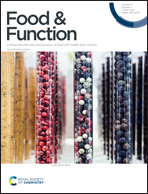Glycosides and flavonoids from the extract of Pueraria thomsonii Benth leaf alleviate type 2 diabetes in high-fat diet plus streptozotocin-induced mice by modulating the gut microbiota†
Abstract
Twenty glycoside derivatives and nine flavonoids from the leaves of Pueraria (P. thomsonii) were isolated by column chromatography and characterized by nuclear magnetic resonance spectroscopy (NMR) and high performance liquid chromatography (HPLC). The contents of twenty glycosides and nine flavonoids from the extract of P. thomsonii leaf (PL) were 173.3 mg g−1 and 134.7 mg g−1, respectively. Two flavonoids with the highest content were robinin (49.28 mg g−1) and puerarin (42.87 mg g−1). Six flavonoids, i.e. puerarin, robinin, rutin, quercetin, quercitrin, and kaempferol showed more inhibitory effects against α-glucosidase than acarbose. PL could effectively increase the level of insulin, decrease the content of fasting blood glucose, reduce lipid accumulation in plasma, ameliorate oxidative injury and inflammation, and relieve liver and kidney damage in diabetic mice. Moreover, PL could increase intestinal probiotics to improve metabolic disorders caused by diabetes and decrease the level of Clostridium celatum to relieve inflammation. This study suggested that PL or its glycoside derivatives and flavonoids regulating glycolipid metabolism and inflammation levels might have the potential to be used to control type 2 diabetes.



 Please wait while we load your content...
Please wait while we load your content...